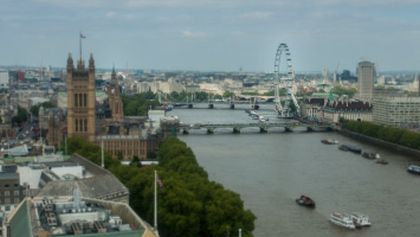
HD VERSION (1920 x 1080 px)
London Skyline from Millbank Tower timelapse with tilt-shift effect – wide skyline time lapse of London. Includes the London Eye, Westminster Bridge, Houses of Parliament, River Thames, Hungerford Bridge and Big Ben. People and traffic on Westminster Bridge appear toy-like due to the tilt-shift effect. 21 seconds
![]()
To buy the 4K (4096 x 2304 px) version click here
To buy the Web (320 x 180 px) version click here
For a watermarked preview click here and use the download link
More about Westminster Bridge (information from Wikipedia)
Westminster Bridge is a road and foot traffic bridge over the River Thames in London, linking Westminster on the north side and Lambeth on the south side. The bridge is painted predominantly green, the same colour as the leather seats in the House of Commons which is on the side of the Palace of Westminster nearest the bridge. This is in contrast to Lambeth Bridge which is red, the same colour as the seats in the House of Lords and is on the opposite side of the Houses of Parliament. In 2005–2007 it underwent a complete refurbishment, including replacing the iron fascias and repainting the whole bridge. It links the Palace of Westminster on the west side of the river with County Hall and the London Eye on the east and was the finishing point during the early years of the London Marathon. The next bridge downstream is the Hungerford footbridge and upstream is Lambeth Bridge. Westminster Bridge was designated a Grade II* listed structure in 1981.
More about the London skyline (information from Wikipedia)
The Greater London area is currently level with the Paris Metropolitan Area as the metropolitan area in the European Union with the most skyscrapers. As of 2014, there are 18 skyscrapers in London that reach a roof height of at least 150 metres (492 ft), with the same figure for Paris (compared to 14 in Frankfurt, eight in Warsaw and five in Madrid).
The history of tall structures in London began with the completion of the 27 metres (89 ft) White Tower, a part of the Tower of London, in 1098.[2][3] The first structure to surpass a height of 100 metres (328 ft) was the Old St Paul’s Cathedral. Completed in 1310, it stood at a height of 150 metres (492 ft).[4] St Paul’s was the world’s tallest structure until 1311, when its height was surpassed by Lincoln Cathedral in Lincoln.[4] It regained the title when the spire of Lincoln Cathedral fell in 1549.[5] Although the spire of the Old St Paul’s was destroyed by lightning in 1561, it still stood as the tallest structure in London,[5] while the world’s tallest structure became Strasbourg Cathedral in Strasbourg, France.[5] St Paul’s was severely damaged by the Great Fire of London in 1666.[4] The title of the tallest structure in London passed to Southwark Cathedral, which stands at a height of 50 metres (164 ft)[6] and no structure in London again rose above 100 metres until 1710, when the current St Paul’s Cathedral was completed.[7] At 111 metres (364 ft), the cathedral remained London’s tallest building until it was overtaken in 1962 by the BT Tower, which was topped out in 1964 and officially opened in 1965.
Few skyscrapers were built in London before the end of the last century, owing to restrictions on building heights originally imposed by the London Building Act of 1894, which followed the construction of the 14-storey Queen Anne’s Mansions. Though restrictions have long since been eased, strict regulations remain to preserve protected views, especially those of St Paul’s, the Tower of London and Palace of Westminster, as well as to comply with the requirements of the Civil Aviation Authority.
The lifting of height restrictions caused a boom in the construction of tall buildings during the 1960s. One of London’s first notable tall buildings was the 117-metre (384 ft) Centre Point, completed in 1966. The National Westminster Tower (now called Tower 42) followed in 1980, which at 183 metres (600 ft) became London’s first genuine “skyscraper” by international standards. It was followed in 1991 by One Canada Square, which formed the centrepiece of the Canary Wharf development. Following a 10-year gap, several new skyscrapers appeared on London’s skyline: 8 Canada Square, 25 Canada Square (both also at Canary Wharf), the Heron Quays buildings, One Churchill Place, the Broadgate Tower and the gherkin-shaped 30 St Mary Axe. Some of the awards given to 30 St Mary Axe include the Emporis Skyscraper Award in 2003[8] and the RIBA Stirling Prize for Architecture in 2004.[9]
With the precedent set by the towers of Canary Wharf and with the encouragement of former Mayor of London Ken Livingstone, a renewed trend for building tall has been established in recent years. There are nine structures actively under construction in London that will rise at least 100 metres in height, besides the South Bank Tower, which is being increased in height by 11 storeys. The Pinnacle, planned to form the centrepiece of the City of London’s skyscraper cluster, has been on hold since 2012

